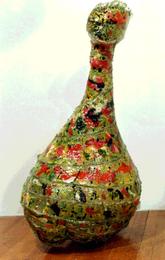| Home | Reviews | Roberta Smith |
Roberta Smith-- New York Times. Dec. 22. 1989. Art Reviews. C.3. |
|||||||
| "Could it be the '70's Again: An Artist Looks Back" - Betty Collings fuses painting with sculpture - |
|||||||
Betty Collings's new work is a kind of contradiction. Her colorful vinyl sculptures may convey a sense of dèjá vu - they hark back to Process Art of the early 1970's - and yet many of them hold their own in the present, as a further development of early 70's concerns and ideals. This quality gives Ms. Collings's show at the Bertha Urdang Gallery, which is her fourth since she started exhbiting here in 1979, a sense of edgy double time. You might want to dismiss it, especially with more than 20 pieces crowded into a gallery that has seen better days as an apartment. But it's not so easy. Even though the viewer must make a special effort to isolate good work from mediocre, some of these pieces are terrific. The best of them exude a playful devil-may-care spirit - the feeling of abstract toys - that has something in common with the art of Alexander Calder. But they also represent a serious effort to fuse painting with sculpture and to liberate color and form, setting them loose in a world that is at once purely visual and full of suggestions and associations. The works on view speak clearly of the early 70's esthetic milieu, and will evoke memories of the efforts from that period of Lynda Benglis, Richard Van Buren and Keith Sonnier, all emerging as artists when Ms Collings was in graduate school at Ohio State University. It was a moment when many younger artists strove to escape the constraints of traditional painting and sculpture. New materials and their processes - plastics, resins and vinyls, for example - were frequently called into play. Art objects might be hung on the wall (or from the ceiling, for that matter) but they tended to aovid the flat or rectangular; they might sit on the ground, but they usually did so directly, without benefit of pedestal. Ascribing to all these principles, Ms. Collings's new work is made of vinyl shaped into big inflatable forms that sit lightly on the floor, hang from the ceiling or, in their most elongated and columnar states, do a bit of both. In fact, all the shapes are distorted columns, mathematically based and related to the helix. Some twist at either end like rams' horns, others bulge unpredictably like eccentric perfume bottles, unfamiliar sea forms or creatures out of Dr. Seuss. Their mathematical aspect has affinities with the art of Ruth Vollmer, whose seemingly organic yet mathematically based sculptures, made mostly in the 1960's, influenced the development of Sol LeWitt, Eva Hesse and Robert Smithson. In the best pieces, the vinyl is a pale translucent green or pink that has random scars and bubbles like those found in Roman glass. (When Ms. Collings ventures into clear plastic, things get garish.) Their surfaces are gaily - yet one suspects, systematically - dotted, dashed or daubed with bright acrylic paint. The seams of the vinyl sometimes curl around the form like a spiral, both enhancing the sense of mathematical impetus and creating paths that seem to determine the paint patterns. Ms. Collings might be described as a second-generation Process Artist who has persisted with ideas brought to prominence, but also largely abandoned, by those more famous than herself. Her art has a deliberateness and a variety that frequently escaped her mentors. In particular, it has a faith in painting and in what the well-laced brush stroke can express that seems more of the 1980's than the 70's. Whatever seems strange or incomplete about her pieces might be laid, in part, to their being out of fashion; it may be hard for eyes sated on the constant quotations and commentaries of 80's art to even see this work. But, as a result, this show provides a valuable articulation of the very things that mitigate against it: the passage of time, the changing of styles and the fading of knowledge concerning work that does not enter the pantheon of recent art. Among many other things, it reminds how quickly one forgets. Exhibit at the Bertha Urdang Gallery, 23 East 74th Street, through January 6. Illustration. |
|||||||
Click on images to enlarge.
| Home | Reviews | Roberta Smith |
